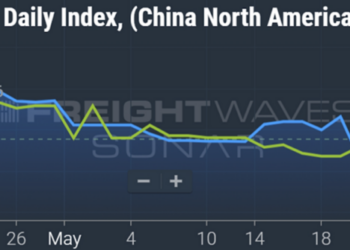The views expressed here are solely those of the author and do not necessarily represent the views of FreightWaves or its affiliates.
In the ever-evolving landscape of logistics and supply chain management, the often-overlooked yard operations are experiencing a technological transformation that promises to revolutionize efficiency.
Although the yard has received more attention from shippers and 3PLs in the past few years, the yard often is still a black hole in the supply chain with a lack of efficiency and very little automation. In a recent study by McKinsey, digital yard management is one of the top three technology solutions that are gathering momentum in the logistics space. (Digital logistics: Technology race gathers momentum)
The future of yard vision and the advent of yard automation are poised to bring about significant improvements in how companies manage their transportation hubs, leading to streamlined operations, reduced costs and enhanced visibility.
Yard operations are the bridge between transportation and the facility, serving as the hub where goods are transferred between trailers and docks. It’s also the first and last point of contact for shipments.
Yard vision, powered by cutting-edge technology, aims to provide real-time visibility into these operations.
One of the core technologies underpinning yard vision is the Internet of Things (IoT). Cameras and sensors help track the movements and statuses of trailers and containers within the yard. This data feeds into a central system that can be accessed by yard managers, enabling them to make informed decisions about resource allocation, traffic management and dock scheduling.
Yard automation systems can efficiently allocate resources, such as yard jockeys and forklifts, to reduce idle time and congestion. This maximizes the throughput of goods in the yard and streamlines operations. Yard vision provides real-time information about the location and status of assets in the yard. This allows for more precise tracking and planning, reducing wait times and increasing the predictability of yard operations. Smart yard automation can optimize the flow of vehicles within the yard, reducing congestion and the associated time and fuel costs. This results in faster turnaround times for trucks and fewer delays.
Automation can replace or augment manual tasks, such as yard checks and manual data entry. This reduces the risk of human error, improves accuracy and frees up labor for more strategic tasks. Yard automation can improve security by monitoring and recording all movements and activities within the yard. This not only deters theft and vandalism but also provides valuable data in case of incidents.
But yard automation is part of the larger ecosystem of supply chain applications. Integration with warehouse management systems and transportation management systems ensures a seamless flow of data and operations from the warehouse to the yard and onward to transportation. Furthermore, yard visibility solutions present another great opportunity to provide additional data insights into the yard and improve yard automation further. This integrated ecosystem approach enhances overall supply chain visibility and efficiency.
The future of yard vision and automation holds even greater promise. Artificial intelligence and machine learning based on vision technology are being integrated to predict and proactively address issues within the yard. For example, these technologies can forecast when a dock is likely to become available and direct an incoming truck to the right spot, minimizing wait times.
Yard vision and automation represent the future of efficient yard management. With cameras, IoT, AI and automation, companies can unlock unprecedented visibility into their yard operations, optimize resource allocation, enhance security and reduce operational costs. The yard is no longer the overlooked part of the supply chain but a crucial component where technology is making a significant difference. As these advancements continue to evolve, they will play an increasingly pivotal role in the broader landscape of logistics and supply chain management.
About the author
Bart De Muynck is an industry thought leader with more than 30 years of supply chain and logistics experience. He has worked for major international companies, including EY, GE Capital, Penske Logistics and PepsiCo, as well as several tech companies. He also spent eight years as a vice president of research at Gartner and, most recently, served as chief industry officer at project44. He is a member of the Forbes Technology Council and CSCMP’s Executive Inner Circle.
The post The next frontier in supply chains: Yard vision and automation appeared first on FreightWaves.













